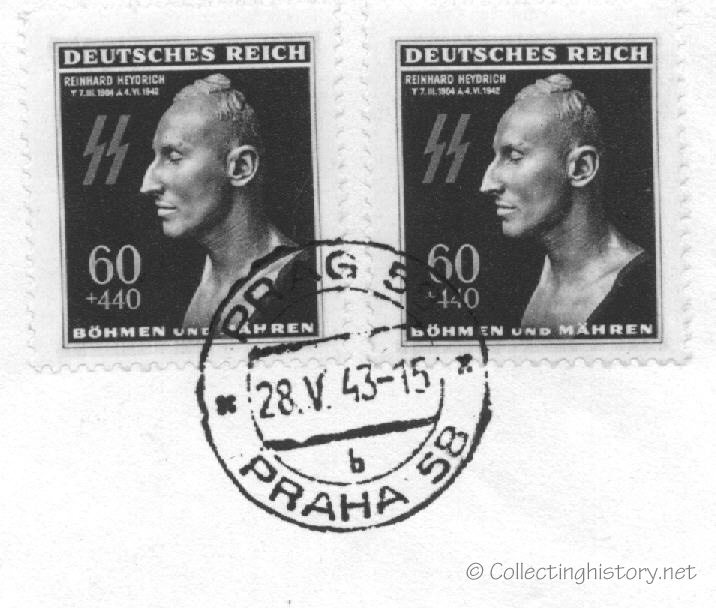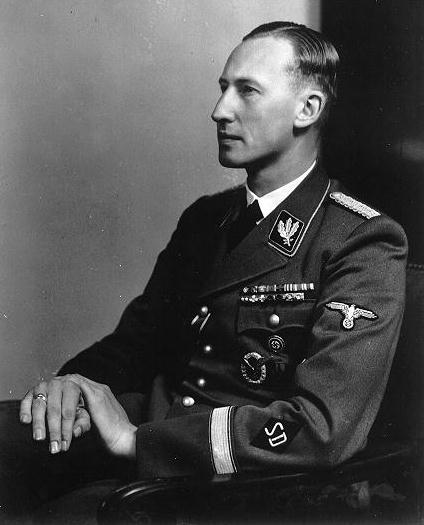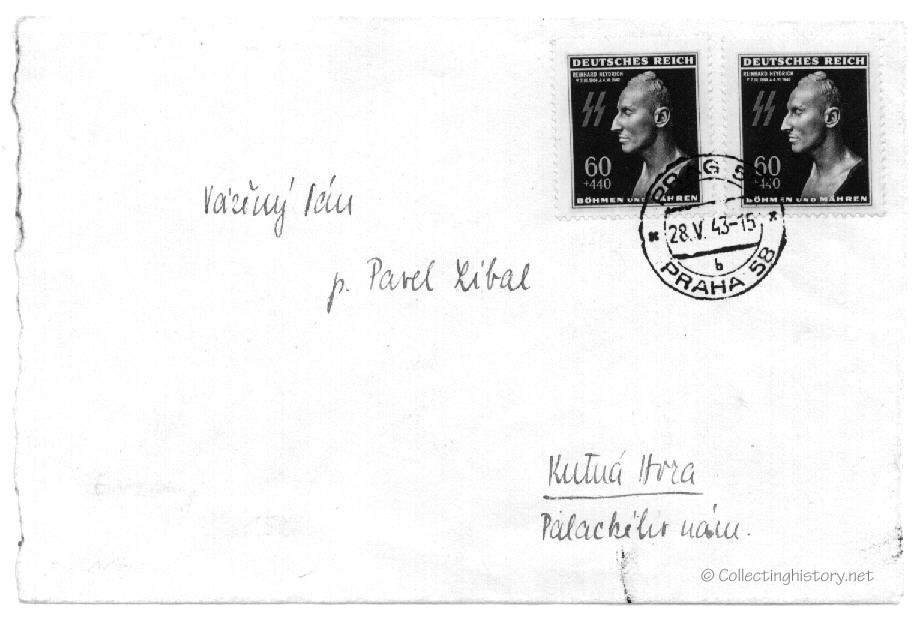

A commemorative stamp honoring a so-called "Martyr of Germany," Reinhard Tristan Heydrich. This is a value-added stamp.
Value-added stamps have a premium attached (over the face value) which is usually targeted for some charitable purpose.
The price printed on the Reichsprotektor Heydrich Commemorative "Death Mask" Stamp is not in marks and pfennigs but in the Protectorate's own currency, the Koruna (pl. Korun), i.e., Crown.
1 koruna consisted of 100 haleru. The exchange rate was 10 K (korun) for 1 RM (reichsmark).
Thus, this value-added stamp cost 60 haleru + 440 haleru (500 haleru total); which equals 5 koruna or 1/2 reichsmark.
It is unknown to this author which organization benefited from the surcharge, although it may have been Frau Heydrich and her children.
The "BÖHMEN und MÄHREN" translates to "BOHEMIA and MORAVIA," the Reich Protectorates that Heydrich administered.
This stamp was issued on the 28th of May 1943, exactly one year and a day after the attack on Heydrich. It also exists in a much rarer form as a special issue miniature sheet containing one stamp, which was given to the 800 or so officials who had attended Heydrich's funeral.

Reinhard Heydrich (1904-1942) was head of the Reich Security Service otherwise known as the Reich Main Security Office (RSHA) which combined the SD, Gestapo, Criminal Police, and foreign intelligence service. He was also Deputy Reich Protector of Bohemia and Moravia and administrator of the concentration camps. In his last office he was known as the "Butcher of Prague."
In the SS hierarchy, Heydrich was second in importance to Heinrich Himmler. He played an important role in Hitler's "Final Solution" and participated in the 20 January 1942 planning meeting known as the "Wannsee Conference."
In September of 1941, Heydrich was appointed Deputy Reich Protector of Bohemia and Moravia in former Czechoslovakia and set up headquarters in Prague.
SS Obergruppenführer
Heydrich liked to travel between his country home and headquarters in
Prague in an open top green Mercedes car without an armed escort, as a
show of confidence in his intimidation of the resistance and successful
pacification of the population.

Heydrich
and his Gestapo chief, Karl Hermann Frank
The Assassination

26
May 1942,
Reinhard Heydrich and his wife Lina attend a concert of his father's
music the evening before the attack by the Czechoslovakian patriots.
On 27 May 1942, as his car slowed to round a sharp turn in the roadway, it came under attack from Free Czech agents who had been trained in England and brought to Czechoslovakia to assassinate him. They shot at Heydrich, then threw a bomb which exploded, wounding him. He managed to get out of the car, draw his pistol and shoot back at the assassins before collapsing in the street.
Himmler rushed his own private doctors to Prague to help Heydrich, who held on for several days, but died on 4 June 1942 from blood poisoning brought on by fragments of auto upholstery, steel, and his own uniform that had lodged in his spleen.
In Berlin, the Nazis staged a highly elaborate funeral with Hitler calling Heydrich "the man with the iron heart."

Heydrich lying in state at the Hradčany castle.

The
monument erected to the memory of Heydrich at the fatal corner in
Prague with a perpetual SS Guard of Honor.
It was destroyed by the Czechs in 1945.
Nazi
Vengeance
Within a short time the Gestapo and SS hunted down and murdered the Czech agents, resistance members, and anyone suspected of being involved in Heydrich's death.
At least 10,000 Czechs were arrested. In addition, 3000 Jews were deported from the ghetto at Theresienstadt for extermination. In Berlin 500 Jews were arrested, with 152 executed as a reprisal on the day of Heydrich's death.
As a further reprisal for the killing of Heydrich, Hitler ordered the small Czech mining village of Lidice to be liquidated on the false charge that it had aided the assassins.
On 10 June 1942, in Lidice, all 172 men and boys over age 16 were shot. The women were deported to Ravensbrück concentration camp where most died. 90 young children were sent to the concentration camp at Gneisenau. Some with Germanic features were taken to Nazi orphanages for relocation within the Reich.
The village of Lidice was then destroyed building by building with explosives, then completely leveled until not a trace remained, with grain being planted over the flattened soil. The name was then removed from all German maps.
Other retaliation reports state:
Louis L. Snyder's "Encyclopedia of the Third Reich" states 860 Czechs were condemned to death at Prague, 395 at Brno. Heinz Höhne's "The Order of the Death's Head" states 1,300 were shot, including all male inhabitants of the village. Time Life's "The Apparatus of Death" states that 13,119 people were arrested; 232 were executed for expressing approval of the attack, and 462 more were executed for possessing weapons or disobeying the police. It further states that in Lidice, the "official German report" said 170 adult males were shot, plus 11 miners returning from the night shift and 15 relatives of the Czech agents. Time Life also reports that the Germans reported removing 84,000 square yards of rubble from the razed village, which they then plowed over and planted with grain to remove any trace of habitation. Eddy Bauer's "Illustrated WW2 Encyclopedia" states that on the day Heydrich died, 1,331 Czechs (including 201 women) were executed, 120 Czech resistance fighters (including the 2 assassins) fought it out and were killed, 3,000 Jews were sent to an extermination camp in the east, and 152 of the Berlin Jews arrested at the time of the bombing were shot. It further states that in Lidice, 192 men and boys, as well as 8 women were shot, 195 other women were sent to Ravensbrück camp where 7 were gassed, 3 disappeared and 42 died. Four pregnant women were taken to Prague where their babies were murdered as they were born, the mothers then being sent to Ravensbrück. The 90 children of the village were "adopted" under German names by German families as a "racial experiment."

These two Heydrich stamps are affixed to an envelope and are postmarked on the first day of issue. The envelope is postmarked "Prag" (Prague) and dated "28.V.43." (28 May, 1943). The envelope is empty and neatly torn open along the left edge, the contents long gone.
Return
to Collecting History
(Thanks
to Dave Chandler for contributing to this page.)